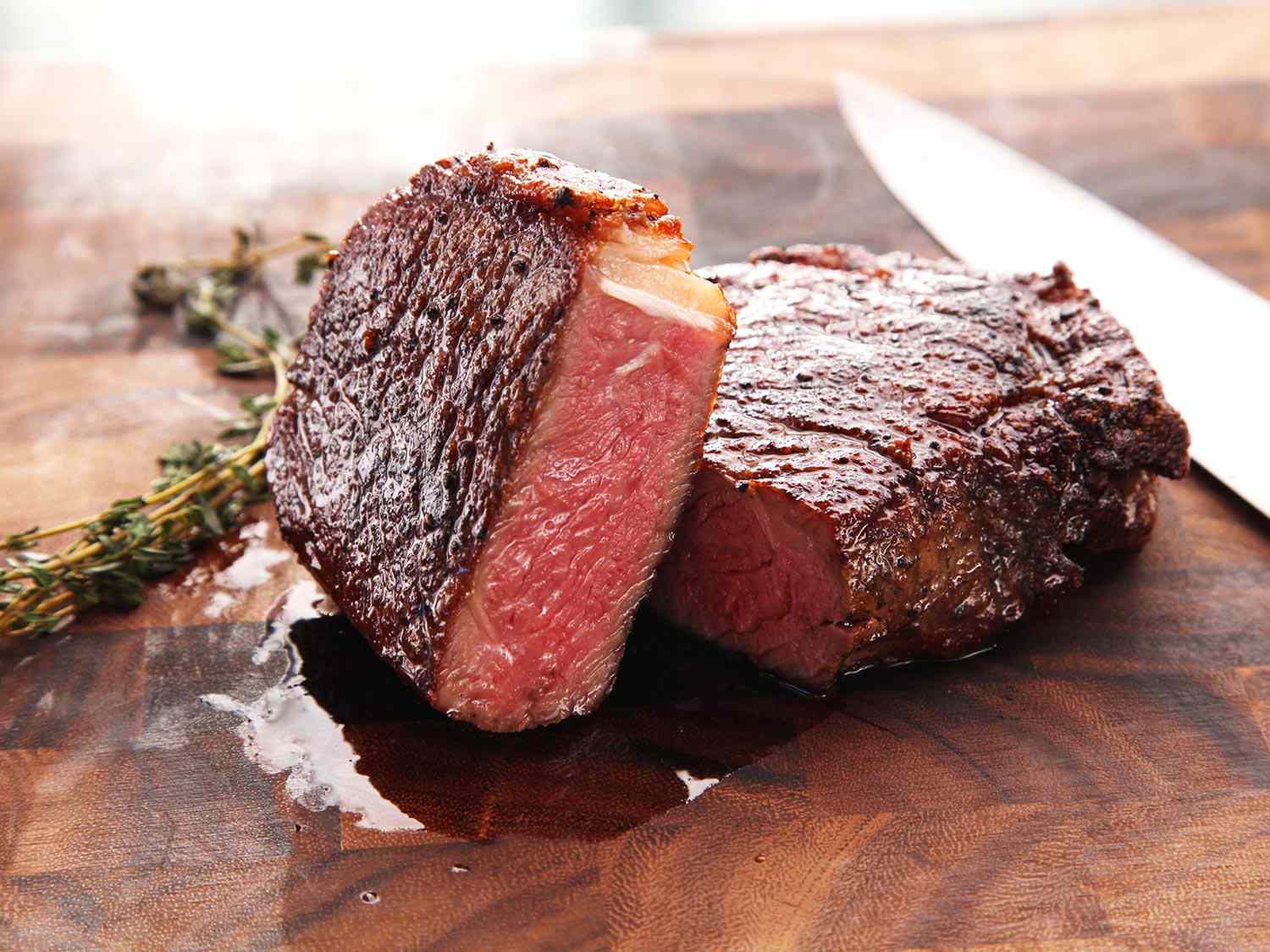Why YSK: When you cook meat, any water on the surface must first evaporate before much browning can occur. You want to get as much of a Maillard reaction as possible in the limited cooking time you have before the meat reaches the correct internal temperature. Removing the moisture first means that the heat of the cooking surface isn’t wasted on evaporation and can instead interact with the meat to form the complex sugars and proteins of the Maillard reaction.
Alternately, if you dry your meat with a duck it will promote the Mallard Reaction.
We call that the dryducken method
And if it’s steak especially, leave it out for a half hour to get closer to room temp before cooking.
Ever since I learned this tip I’ve been cooking perfect steaks. Makes a huge difference.
And you can leave it uncovered in the fridge (use a rack and a drip pan) and the airflow will dry the outside. This gives a better sear overall.
If you don’t have the time (or the foresight) to salt it hours ahead, the next best alternative is to salt RIGHT before cooking. If you salt 10-30 minutes before, osmosis will draw moisture out of the meat, which will then either be wiped away or evaporated. Salting hours ahead of time gives the moisture time to diffuse back into the meat with the salt it dissolved.
This is the right tip. If you can’t dry brine with salt overnight, then salt right before you hit heat.
That being said, give me a 24 dry brine plus reverse sear any day.
Absolutely. Long dry brine is the preferred method, but if you just remember an hour before it’s rime to cook, it’s better to wait until just before it goes in the pan.
I personally prefer just straight on the pan after a dry brine instead of reverse sear, but that’s probably because I prefer it cooked rare.
And ALWAYS rest your meat after cooking it before slicing into it for 10 minutes or so
OOoo I haven’t tried that, I’ll do that next time.
I do this all meats, especially skin-on chicken. Gets that perfect crispy skin every time
This
This has virtually no impact. Salt is more important.
Depends on how you’re cooking. It’s all about that heat gradient!
Out on an open grill on medium heat for 20 minutes? Yeah, literally zero difference.
Pan fried on a cast-iron skillet that you’ve cranked up to ludicrous mode? That shit better be room temp if you want the inside to reach a safe temperature!
… and to those of you who cook steak but have never panfried: what are you doing? Get yourself some peanut oil, crank the heat to 11, and get cooking ASAP. Look up a guide because nailing the doneness will be hard, but I guarantee you that you’ll become a better cook after a few attempts. It’s a rite of passage, my fellow meatheads.
In the case of your own fried/ludicrous mode example, leaving the steak out at room temperature for even a few hours has basically no effect. It takes a long time for the bulk of the steak to warm any appreciable amount.
“After the first 20 minutes—the time that many chefs and books will recommend you let a steak rest at room temperature—the center of the steak had risen…not even a full two degrees…After 1 hour and 50 minutes, the steak was up to 49.6°F in the center”
I use a meat thermometer to gauge when it’s room temp, so I know how long it takes (spoiler: about a day).
I’m not great about food safety so keeping meat out that long is usually a recipe for food poisoning – that’s why I cheat by putting it in the microwave on 10% power for 3 rounds of 5 minutes. This usually gets the steak 90% of the way to room temp with minimal cooking. After that, I wrap the steak completely in cling-wrap and let it rest another hour (the cling wrap prevents evaporative cooling) – this gets me all the way to room temparature and I’m off to cooking.
Thermometers ftw.
I’m just out here trying to do an entire meal on the bbq
I can never get the rice quite right
A fresh steak should be safe to eat raw. I’ve never heard of a target temp for food safety for steak either tbh.
If anything bringing steak to “room temp” would be more likely to bring it in a danger zone.
I’ve never heard of a target temp for food safety for steak either tbh
Well… believe it or not there is a suggested internal temperature for cooking beef, even if it’s not ground. The CDC recommends 145F (~63C) and FSA recommends 70C (~158F). It’s certainly true that beef is one of the safer meats to eat at undercooked temperatures (at least in the U.S. & U.K.), but it’s also true that you can achieve just about any level of doneness beyond blue while still following food safety guidelines.
As I’ve said elsewhere, I have difficulty maintaining a super-sterile kitchen, so I can’t practically leave meat out at room temperature all day without risking food poisoning. I instead opt to expedite the process by microwaving at low power. Even if you view these guidelines as silly, there remains the practical application of being able to sear thicker cuts without leaving an overly raw center. When your total cook-time is <5 minutes, these things matter.
Cooking a fresh steak to 63 degrees sounds like a waste of money to me. ( And so does cooking chicken to 70) But I think we can all agree to that because we know those are the temperatures that indicate safety if it reaches that for 1 second. And lower temperatures over time are also good.
Generally I prefer reverse searing steak because it allows for a tender perfect inside with a hard crust and no gradients in the doneness. But if I don’t have time for that (or for a sous vide waterbath) I just cook straight out of the fridge in a cast iron while flipping every thirty seconds. And for anyone doubting that flipping 30 seconds is superior to not touching it before flipping once: your steaks will be less evenly cooked which I don’t like but you are free to do so ofcourse. Read Kenji’s article on it if you don’t believe me: https://www.seriouseats.com/the-food-lab-flip-your-steaks-and-burgers-multiple-times-for-better-results
Letting it reach room temp contributes little to nothing, in comparison with patting it dry, because of a few details:
- Maillard reaction happens around ~150°C, so above the boiling point of water (100°C)
- If there’s liquid water, it’ll snip all available heat from the surroundings, when boiling, before the temperature rises up again. This means no Maillard until the water is gone.
- It takes 1cal to raise the temperature of 1g of water by 1°C. It’s a relatively small amount of heat, even for something like 25°C room temp vs. 5°C fridge temp.
- It takes 540cal to transform 1g of 100°C liquid water into 1g of 100°C steam. It’s a lot.
So if you don’t wait until your beef reaches room temperature before cooking it, you’re losing, like, 20cal per gram of beef to unnecessarily raise its temperature. However if you don’t pat your beef dry, each gram of water soaking there will be stealing 75cal to rise its own temperature to 100°C, plus 540cal to steam off. And since browning is a surface reaction and the offending water is mostly on the outside the difference is fairly big, as you aren’t comparing the whole chunk of beef with the outside water - you’re only comparing the surface beef with the water.
(I hope that this is clear, I’m damn convoluted to explain stuff.)
I’ve never seen a comparative experiment that confirms this habit and I don’t see how that would make a difference. Especially not if you use a thermometer.
Empirical evidence suggests that it takes many hours for the center of the steak, the part that matters for doneness, to rise any appreciable amount.
Drying the outside of your steak is good advice because your can see the results. The same with brining because you can taste it.
If your technique is otherwise good whether that’s low/slow or hot/fast then “letting it warm up” is just bunk advice.
Another note is that if your cooking set up can’t crank up high enough to get a good sear fast then you may benefit from the center being cold to start with to give you more time to develop the crust.
Rest it for 2 hours at room temp with salt on salt on it
oooh. salt on salt action.
I’m not sure if it is covered in the article but you can achieve extra maillard reaction with a more deeply seasoned, juicer, tender steak with a dry brine.
It’s super simple, it just takes time. Salt your steak all over and stick it in the fridge on a wire rack overnight.
If you check the steak within about 3 minutes you’ll see the salt drawing out moisture into little beads on the surface. This would be a bad time to cook, you’d lose that moisture and waste energy boiling the surface liquid off your meat, resulting in a grey bland steak. Over the next hour the juices dissolve the salt, making the brine. Leave it for several hours and the salt will diffuse into the meat and… Do science to the protein (read the dry brine article on serious eats, it explains all!). This will make the interior of the steak extra juicy and the exterior extra dry for a great crust. If you put the steak on the rack the circulating air also dries out the surface.
If you’re buying a decent steak it’s well worth the near zero effort that this takes.
For the ultra lazy, typically me but I do love cooking some good steaks so it’s worth the effort, I’m assuming this is it: https://www.seriouseats.com/how-to-dry-brine
That’s the one, thanks for linking. I typed that up on my phone and couldn’t be bothered finding it, but Lemmy deserves better!
It’s a good read, they have some great technique articles.
I buy lousy steaks, will this technique elevate a lousy steak to a mediocre steak?
My time is literally not worth as much as buying a better cut of meat.
It absolutely should, looking back at my post I’m not sure why I worded it like that, but it will improve cheaper cuts. Your mileage may vary and you still want to do a good job actually cooking the steak, but the salt will do exactly the same thing. As it travels through the interior of the steak it will season it deeply, meaning every bite it properly seasoned, not just the surface. Meat loses moisture during cooking as high heat tightens the muscle fibres, squeezing out liquid. The salt will loosen muscle fibers, which squeezes out less liquid. Apparently some of those proteins also break down into a gel like liquid which clings onto the meat better. All of this I would imagine is actually probably more beneficial to cheaper cuts.
If you know you’re eating steak tomorrow, prep it now! In fact, I have always left it for 12 - 24 hours, but depending on how thick the steak is, a couple of hours is probably fine and will be better than not doing it at all. Just be sure the steak has reabsorbed all of the liquid that the salt drew out in the first place.
Understood: I will freeze dry all meat before cooking it to remove all moisture.
You only want the surface dry.
Gotcha. I’ll carve off the edges of my steak, freeze dry those, and use meat glue to reattach them to the main, non-dried steak after.
Why don’t you just cover the steak in those silica gel desiccant beads like a normal person? Weirdo.
Well that just makes good sense.
What the fuck.
deleted by creator
nah just gonna wrap it in cheese
you’re basically just dry aging it at that point, no?
deleted by creator
That’s just dry aging with extra steps!
subbed to that channel, thanks!
Finally, an actual and legit YSK. Thank you very much my good sir.

Dear God
God had no part in this travesty, that’s for sure.
They can’t stop you from ordering a steak and a glass of water!
That is true. I like using a propane torch. The water will evaporate quickly and you get that extra crunch very easily without cooking the inside too much. Especially with with first slow cooked meat and then finish with the torch. Water will evaporate from surface quickly.
I really need to get a kitchen torch huh
Life hack: all you really need is a lighter and your favorite flavor of hairspray or spray paint.
Does this apply to ground beef? Cuz I’m curious how I would effectively dry that without just making a mess. Is it just the same as a steak and patting it with a paper towel would be enough?
How often is your ground beef wet? Regardless I feel like most applications of ground beef you typically wouldn’t have to worry about it, you’re always cooking it well done for the most part so it will brown, like ground beef in a pan for tacos or hamburger helper type stuff.
If it’s for burgers and it’s wet for some reason, then yeah a paper towel pat down would be fine, but idk typically when I’m handling ground beef even forming my own patties I wouldn’t really ever describe it as all that ”wet”.
Yeah for burgers. I’m cheap and usually just have frozen premade patties, which is why they would be wet.
If they are thawed and very wet then it wouldn’t hurt to dry them. I have also heard that they brown best if you minimize the number of flips, ideally just one flip if you time it correctly.
I’d use cloth or you may leave bits.
For ground beef, the best solution is to make sure you have enough fat to get good browning. People usually say 80/20 ratio, but I like to have 25% fat on my burger patties. As an experiment, try making a patty with lean meat and you will see how much the moisture will evaporate rapidly and take the heat away from the meat, giving you a sad grey meat. With enough fat, it will keep conducting heat into the crust without boiling all the water inside; as a bonus, you get juicy burgers this way.
There are people who cook wet meat? I mean there are people who do not know that baking soda is a wonderful tenderizer.
Hello, I am people
Every day, that list of people grows: https://xkcd.com/1053
The wife is not a fan of my forking methods of tenderization.
Unbrowned steaks are surely regretted,
But Froyn just likes their meat wetted
So, both in kitchen and bed,
The same can be said:
Their wife just hates their forking method
Yes, lots of people don’t dry off the marinade when cooking marinated meat. Which shouldn’t be an issue with a steak but just as an example.
Then sometimes people don’t dry off meat well enough after washing it. Just a quick dab with some paper towel is often not enough.
But yes, the title isn’t the best and the Article itself uses a different one and goes more into detail. It suggest air drying your steak for hours in the fridge. That’s definitely not something everyone does. It also goes more into detail about the Maillard Reaction.
But why on earth are you washing your meat?
My parents ALWAYS marinate their steaks in a ziplock bag of liquid marinade, and subsequently cook them to a rubbery puck of grey meat. Suggestions to change their ways is futile - Americans don’t like being told they bbq incorrectly…
I did this on Sunday, but it was cooked maybe medium rare. I haven’t cooked a lot in my life. What should I do if I want to marinate next time?
Honestly, I’ve stopped seasoning my steak beyond salt and pepper and wouldn’t personally marinate anything other than something like a skirt steak for fajitas anymore.
If I were to marinate again, I would pull the steak out of marinade and let if drip dry over a towel for 30 minutes or so (or as long as I had patience for - I’m guilty of allllllways cutting corners).
I mean, I don’t cook it sopping wet, but I am lazy…
Sometimes people don’t dry meat after washing it. Which is fine for some dishes. Or if they dry it they don’t do it well enough. But ye, the title isn’t that well chosen.
The article talks about letting meat air dry for several hours in your fridge. And goes further into the Maillard Reaction.
You really shouldn’t wash meat. It doesn’t serve any purpose except to possibly spread the bacteria that may be present to other places. Best thing to do is just cook it to proper temperature.
there are people who do not know that baking soda is a wonderful tenderizer.
Whaaaaaaaaaat
thats interesting, now im curious if it would help for mine, i usually put a lite coating of oil on my steaks then cook at 700 degrees, i found the oil helps with the charring but still gets good marks on the meat.
Putting any piece of meat on the grill at 700° is going to leave good marks.
I usually put mine on at 45° but then rotate it to 90° to get good grill marks. /s
Meat is murder y’all/s I prefer soy
Meat yummy
Look at Beast Boy over here. x
How can you be certain plants aren’t also aware they are being killed? We already know that plants communicate with each other.
I like the murder. I just prefer the taste of soy
Adding some detail. Evaporating water takes way more energy than just heating it up.
When you put energy (heat) into water that’s below 100c it gets hotter. When you add 4,184 to a liter of water the temperature goes up by 1c. If the water is already at 100c it takes 2,260,000 to turn that into 100c steam. The energy that goes into turning water into steam isn’t going into the steak.
So if you put a wet steak on the grill it will create an insulating layer of steam that keeps the steak at around 100c (even if the pan is above 100c).
That’s also why you only salt your steak right before or after heating it. If you let salt sit on the steak it will draw out moisture, reducing the Maillard reaction and drying out the steak.For a great practical way to grill the steak perfectly, check out videos on “cold searing”.
You can and should actually salt your steak several hours before cooking, leaving them uncovered in the fridge. Water will be drawn out, and then reabsorbed along with the salt. Dry the surface and salt again if desired right before cooking.
Yep, salt the steak heavily the night before and leave on a wire rack in the fridge uncovered. This is called a dry brine and it’s miles better than the bland steak you get with a salty crust and watery inside if you only salt just before or after cooking.
How do I know if the beef is dry?
How do I dry beef?I tried googling, but I only get results about aged steak. Is that the same thing? I hope not
To dry the beef you just use a paper towel to pat dry the beef.
It’s not the same as aged steak. OP’s post is simply about patting your meat dry with a paper towel or similar prior to cooking.
Paper towels or constant air flow over a few minutes. Usually paper towels.
I just grab some paper towels and start blotting the surface. The goal is to get as much of the liquid off the surface as possible.
Leave your steak/chops in the fridge either uncovered or loosely with paper towel, and the meat surface should be dried enough to get a good browning.
Does this apply to hamburger too?
A good amount of liquid is going to come out of beef regardless. That’s why it’s good to have a smoking hot pan or grate to start with.
No Hamburger is a special kind of beef.
Pretty sure this is sarcasm, but it is not wrong, so also not sure.
Sort of. If you’re doing burgers, you don’t usually need to pat it dry, but you also don’t salt it until just before you put it on the pan/grill. Salt still draws out moisture and changes the protein structure especially in ground beef.
But hamburger is definitely different to beefburger? Right? Does anyone actually make hamburgers any more?
Generally no. Ground beef doesn’t have a “surface” the same way a cut off meat does. As meat cooks fibers (can’t remember if it’s the muscle of the protein fibers specifically) contract and squeeze out water. In ground beef the water will be escaping every which way. In a cut of meat more of that water has a better chance of staying within the piece.
To a degree yes. Moisture in general will limit browning. Fresh ground beef is usually dry enough. Frozen and defrosted ground beefwill have ice/water. Patting it dry with a paper towel takes care of this.
Ground turkey in particular is super wet all the way through so paper towels won’t really be able to get it all. To brown ground turkey, you put a big patty on the grill and don’t break it up, then wait for several minutes. This allows the surface to evaporate the water and then begin browning. If you break it open it will release the water inside the big ball of meat and it’ll take forever to evaporate enough for browning to start. You break it open later on after you’ve browned top and bottom.






















